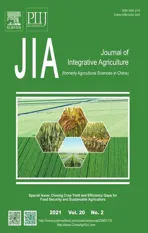Geographic variation in the yield formation of single-season highyielding hybrid rice in southern China
2021-01-18WANGDanyingLlXuyiYEChangXUChunmeiCHENSongCHUGuangZHANGYunboZHANGXiufu
WANG Dan-ying,Ll Xu-yi,YE Chang,XU Chun-mei,CHEN Song,CHU Guang,ZHANG Yun-bo,ZHANG Xiu-fu
1 State Key Laboratory of Rice Biology,China National Rice Research Institute,Hangzhou 310006,P.R.China
2 Crop Research Institute,Sichuan Academy of Agricultural Sciences,Chengdu 610066,P.R.China
3 Hubei Collaborative Innovation Center for Grain Industry,Yangtze University,Jingzhou 434025,P.R.China
Abstract Environmental conditions greatly affect the growth of rice. To investigate the geographic differences in yield formation of single-season high-yielding hybrid rice in southern China,experiments were conducted in 2017 and 2018 in the upper and middle–lower reaches of the Yangtze River with 10–30 main locally planted high-yielding hybrid cultivars used as materials.Compared with rice planted in the middle–lower reaches of the Yangtze River,rice planted in the upper reaches has a longer tillering duration,higher accumulated temperature (≥10°C) during tillering period,but lower accumulated temperature and solar radiation from initial booting to maturity. Yield traits comparison between the upper and the middle–lower reaches of Yangtze River showed that the former had 48.1% more panicles per unit area while the latter had 46.4% more grains per panicle; the rice yield in the former was positively correlated with the seed setting rate and the dry matter accumulation before heading,while the latter was positively correlated with grains per panicle and dry matter accumulation from booting to maturity. Comparison of the same variety Tianyouhuazhan planted in different regions showed there was a significant positive correlation between panicle number and the duration of and accumulated temperature during the tillering period(r=0.982**,r=0.993**,respectively),and between grains per panicle and accumulated solar radiation during booting period(r=0.952*). In the upper reaches of the Yangtze River,more than 90% of cultivars with an yield of greater than 11 t ha–1 had an effective panicle number of 250–340 m–2,and there was a significant negative correlation between seed setting rate and grains per panicle; therefore,the high-yielding rice production in these regions with a long effective tillering period (>40 d)should choose varieties with moderate grains per panicle,adopt crop managements such as good fertilizer and water measures during vegetative growth period to ensure a certain number of effective panicles,and to increase the dry matter accumulation before heading. While in regions with a short effective tillering period (<20 d) but good sunshine conditions during the reproductive growth period,such as the middle–lower reaches of the Yangtze River,high-yielding rice production should choose cultivars with large panicles,adopt good water and fertilizer managements during the reproductive growth period to ensure the formation of large panicles and the increase of dry matter accumulation after heading.
Keywords:single-season hybrid rice,geographic variation,yield,climatic factor,southern China
1.lntroduction
Yangtze River basin is the most important single-season rice production region in southern China,which includes 12 provinces and cities,extends from 21°08´N to 35°20´N and from 97°31´E to 122°30´E,accounts for approximately 2/3 of the rice planting area of the whole country. Rice production in Yangtze River basin can be further divided into the upper reaches (Yunnan,Guizhou,Sichuan provinces and Chongqing City) and the middle–lower reaches of the Yangtze River (Hunan,Hubei,Jiangxi,Anhui,Jiangsu,Zhejiang provinces and Shanghai City). Climatic factors vary substantially over Yangtze River basin. The annual accumulated temperature above 10°C,sunshine hours and precipitation are different in the upper and the middle–lower reaches of the Yangtze River basin. Rice production is a combination of cultivar performance,ecological environment and production management. This climatic variation significantly influences rice growth and grain yield and leads to variations in rice cultivar performance and production management (Taoet al.2006; Donget al.2011; Yanget al.2014; Liet al.2015; Huet al.2017; Rezaeiet al.2017). To guarantee a stable rice yield and national food security,it is important to understand the impacts of climatic factors on rice growth and the geographic variation in yield formation in southern China.
Grain yield is determined by panicles per unit area,grains per panicle,seed setting rate,and grain weight. Previous work has shown that there is a strong compensatory mechanism between panicle per unit area and grains per panicle,and it is not easy to achieve an increase in both(Milleret al.1991; Gravois and Helms 1992; Chenet al.2005; Ottis and Talbert 2005; Liet al.2014). In the 1960s,high-density planting to increase panicle number per unit area was recommended in inbred rice production (Fagada and De Datta1971; Wuet al.1998). After 1980,with the development of hybrid rice varieties,many works have shown that increasing panicle size rather than panicle increases yield; for example,Yuan (1997) reported that breeding large-panicle varieties is an effective way to achieve super high yields,and Linet al.(2000) believed that in rice cultivation,increasing grains per panicle on the basis of suitable panicle number is the key to the high yield of rice,Yanget al.(1996) insisted that,in terms of achieving efficiency of yield components,spikelets per panicle>panicles per unit field. However,Huanget al.(2011)found that although high-yielding super rice cultivars have more grains per panicle than ordinary hybrid and inbred cultivars,panicles per unit area had the strongest positive contribution to grain yield when only the super hybrid cultivars were analyzed. Although all the authors agreed that high biomass production is essential for high grain yield,some indicated the importance of dry matter production after heading (Jianget al.1988),while others reported that dry matter accumulation before heading is more important(Saitohet al.1993; Katsuraet al.2007; Liet al.2012). Thus,although there are many studies on yield formation and biomass production in term of high-yielding production,the results from specific experiments are inconsistent or even contrasting,which brings great trouble to guide high-yielding rice production.
All these inconsistencies may be due to regional differences. Climate has regional characteristics,and regional changes in climate will inevitably lead to regional changes in cultivar performances and planting management (Liet al.2015; Luet al.2017). The results drawn from a specific experiment may differ from those of other regional trials and suit only a particular location. To date,little research has been conducted on the geographic variance of the yield formation of high-yielding hybrid rice production in southern China. In this study,using the main local high-yielding hybrid cultivars as materials,we compared the yield components and biomass production in the upper and middle–lower reaches of the Yangtze River basin. Our objective was to identify the geographic variation in the yield formation of high-yielding hybrid rice in southern China; and to provide guidance on cultivar selection and crop management practices for highyielding rice production in different regions.
2.Materials and methods
2.1.Site description
Field experiments were conducted at four sites in 2017 and two sites in 2018. In 2017,two sites were located in the upper reaches of the Yangtze River rice region (U1,Mianzhu,Sichuan Province; U2,Zhongjiang,Sichuan Province),two sites were located in the middle–lower reaches of the Yangtze River rice region (M,Jingzhou,Hubei Province;L,Fuyang,Zhejiang Province); in 2018,experiments were conducted in U1 and L. Details of the geographical positions and environmental conditions are given in Table 1. Before transplanting and fertilizing the crop,five soil cores were collected diagonally from the 0–20 cm soil layer at each site,and the primary soil properties were analyzed (Bao 2007). The soil physicochemical properties are given in Table 2. The accumulated temperatures above 10°C,sunshine hours and precipitation from March to October in the Yangtze River basin were 4 950–5 535°C,642–1 326 h and 568–1 158 mm,respectively (Table 1,data were obtained from National Meteorological Information Center,http://data.cma.cn); the solar radiation was calculated form sunshine hours (Allenet al.1998). From March to October,the average temperature,minimum temperature and solar radiation in the upper reaches of Yangtze River are all lower than those in the middle–lower reaches of Yangtze River,especially during July to October (Fig.1).
2.2.Experimental design
At each experimental site,12–30 local high-yielding hybrid rice cultivars were selected as materials (Appendix A) and were arranged in a completely randomized block design with three replicates. The planting area of each cultivar was 12 m2in each plot.
Rice planted according to local high-yielding cultivation methods. At U1 and U2,organic fertilizer (1 500 kg ha–1,approximately 45 kg N ha–1),inorganic compound fertilizer(400 kg ha–1,N:P2O5:K2O=15:15:15) and potassium (90 kg K ha–1) as KCl were applied before transplanting. Nitrogen was topdressed as urea in three splits:1 week after transplanting(35 kg N ha–1),at tillering (35 kg N ha–1) and at panicle initiation (48 kg N ha–1),and potassium (60 kg K ha–1) as KCl was topdressed at tillering. At M and L,270 kg N ha–1was applied in four splits,50% as organic fertilizer (5%total N on weight basis) were applied before transplanting,and other 50% N as urea was applied at tillering (20%),panicle initiation (20%) and flowering (10%). Potassium at the rate of 240 kg K2O ha–1was applied as basal dressing(60%) and at panicle initiation (40%) in the form of KCl.Phosphorus at the rate of 120 kg P2O5ha–1in the form of calcium superphosphate was applied as a basal fertilizer.
In all sites,pre-germinated seeds were grown in the seedling trays filled with soil to produce uniform seedlings,and seedlings were transplanted with a hill spacing of 30 cm×20 cm and two seedlings per hill (the seeding date and transplanting date are shown in Table 3). The field was flooded after transplanting and was drained for 7–10 days to control unproductive tillers at the end of the tillering period.After this,a water depth of 3–5 cm was maintained until 7 d before maturity. Weeds and insects were intensively controlled by chemicals to avoid biomass and yield loss.
At the tillering,initial booting,heading,mid-grain-filling,and maturity stages,the number of tillers from 30 hills of rice was counted,and six hills were randomly sampled from each plot. The dry weights of the plants were determined after being oven-dried at 70°C for 48 h and a constant weight was reached. At maturity,the grain yield was determined from a harvested area of 5 m2and was converted to kilograms per hectare at 14% moisture content. The panicles of the above mentioned six sampled hills were hand threshed,and filled spikelets were separated from unfilled spikelets by submerging them in tap water. The dry weights of straw,rachises and filled and unfilled spikelets were determined after oven drying at 80°C to constant weight. Three subsamples of 20 g of filled spikelets were collected and counted to determine the grain weight (20divided by the number of filled spikelets),and the number of filled spikelets was calculated as the total dry weight of the filled spikelets divided by the grain weight. All unfilled spikelets were counted and the number of total spikelets(filled and unfilled) was calculated. The aboveground total dry weight at maturity included the total dry matter of the straw,rachises and filled and unfilled spikelets. Dry weight accumulation during the grain-filling phase was calculated as the difference in total aboveground dry weight between the flowering and maturity stages. The number of spikelets per panicle (ratio of total spikelet number to panicle number),grain-filling percentage (ratio of filled spikelet number to total spikelet number) and harvest index (HI) (ratio of dry grain yield to total aboveground biomass dry weight) were calculated.

Table 1 Locations and environmental conditions of the experimental sites in 2017 and 2018

Table 2 Soil physiochemical properties of the experimental sites in 2017
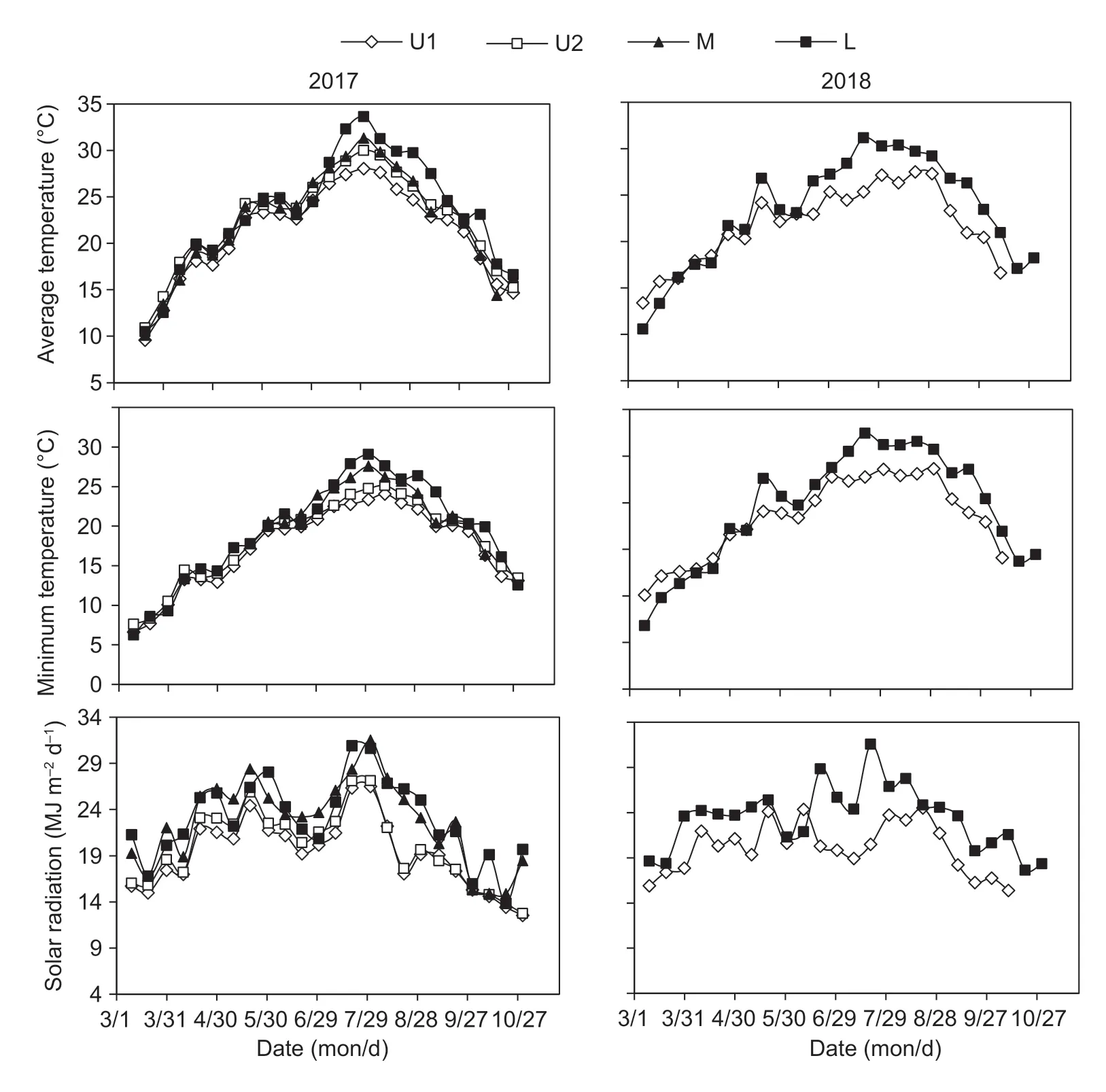
Fig.1 Daily mean temperature,the minimum temperature and solar radiation from March to October at different experimental sites in 2017 and 2018. U1 and U2,Mianzhu and Zhongjiang in Sichuan Province; M,Jingzhou,Hubei Province; L,Fuyang,Zhejiang Province.
2.3.Statistical analysis
An analysis of variance (ANOVA) was carried on the experimental data for 2017 and 2018 using PROC GLM in SAS (version 9.4,Institute Inc.,Cary,NC,USA). The statistical model used included sources of variation due to replication,year,region,and the interaction of year×region;the differences among sites in the same year were also compared using the least significant difference (LSD) test at the 0.05 probability level. The bivariate correlations between the grain yield,yield components and aboveground biomass were conducted using the Pearson correlation coefficient (two-tailed),and partial correlations between yield traits and the duration,accumulated temperature and solar radiation during different plant growth periods were analyzed (two-tailed).
3.Results
3.1.Growth comparison of the main cultivars planted in different regions
Geographic variation in plant growth periods and climateconditionsFrom the upper reaches to the lower reaches of the Yangtze River Basin,the sowing date of singleseason rice was gradually delayed,and so was the maturity date (Table 3). High-yielding rice in the upper reaches of the Yangtze River (U1 and U2) was sown in late March,transplanted before May and harvested before September 6.However,seeds were sown in May and matured from the end of August to October in the middle–lower reaches (M and L) of Yangtze River basin.
There was significant geographic variation in plant growth duration (Fig.2). The average single-season hybrid rice growth duration in the upper reaches (U1 and U2) was 156.2 d,while that in the middle–lower reaches (M and L)was 134.6 d. The whole rice growth duration in the upper reaches of the Yangtze River was 16.0% longer than that of the middle–lower reaches. Comparing the duration of seedling,tillering,booting,and grain-filling growth periods at different sites,we found that the regional difference in tillering duration was the greatest,and the average tillering duration in the upper reaches was 64.2 d,which was 60%longer than the average value of 40.1 d in the middle–lower reaches. The hybrid rice planted in the middle–lower reaches of the Yangtze River includedindicaandjaponicacultivars,but only hybridindicacultivars were planted at U1 and U2 in the upper reaches,therefore,the variation in the length of growth periods among cultivars was greater in the middle–lower reaches of the Yangzi River compared with that in the upper reaches.
In the upper reaches of the Yangtze River,the average length of seedling,tillering,booting,and grain-filling durations accounted for 17.4,42.0,18.6,and 22.0% of the whole plant growth duration,respectively,while in M and L in the middle–lower reaches,they accounted for 21.2,28.8,23.8,and 26.2% of the whole plant growth duration,respectively (Fig.2). The ratio of the vegetative growth period to the reproductive period (including grain filling) in the upper reaches of the Yangtze River was almost 60:40,while it was 50:50 in the middle–lower reaches of the Yangtze River rice region.
There were obvious differences in light and temperature conditions in the different growth periods (Fig.3). Compared with that in the middle–lower reaches of the Yangtze River,the effective accumulated temperature (≥10°C) in the upper reaches is higher at the tillering stage but lower at thebooting stage,and no significant difference was observed between the upper and middle–lower reaches during the grain-filling period. Although the illumination conditions varied greatly between years,the two-year results show that compared with that in the middle–lower reaches of Yangtze River,the accumulated solar radiation in the upper reaches was significantly higher in the vegetative growth period,but lower in the reproductive growth and grain-filling periods.

Table 3 Geographic variation in the date of the main growth stages in the upper reaches (U1 and U2) and the middle–lower reaches (M and L) of the Yangtze River in 2017 and 2018
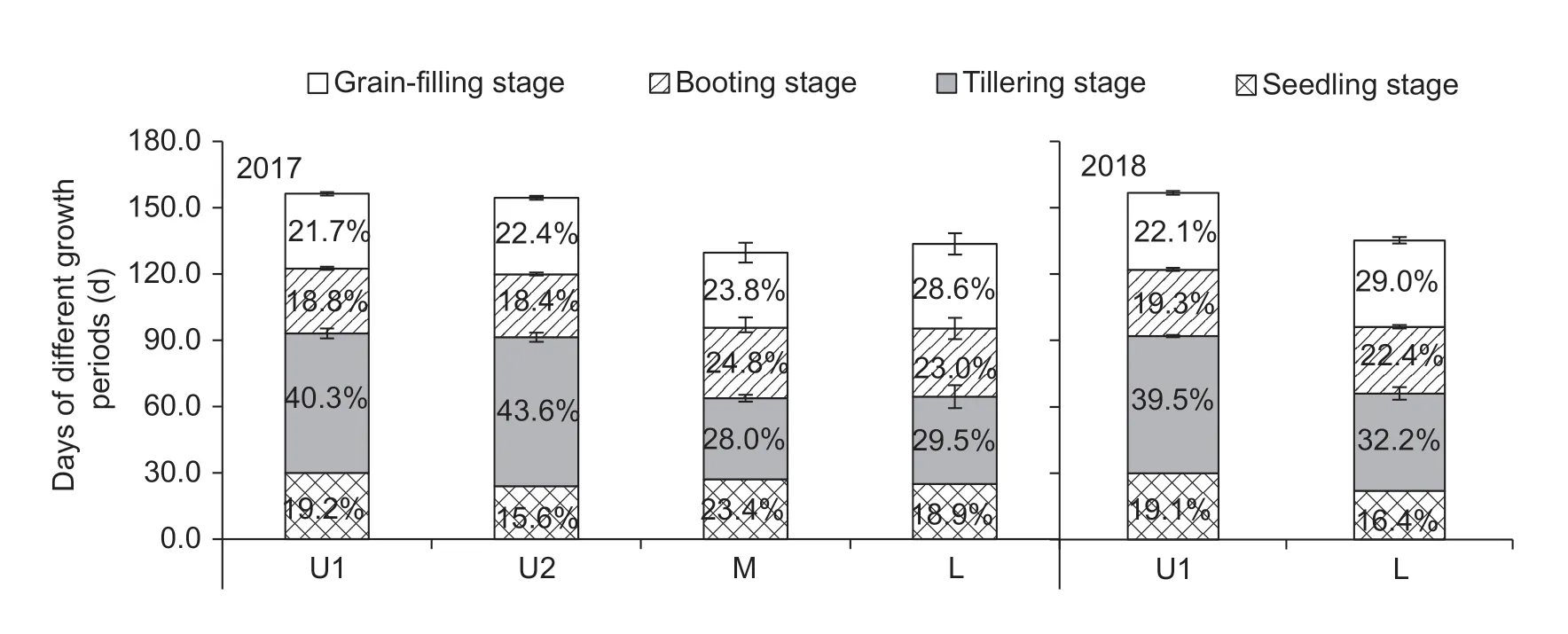
Fig.2 Geographic variation in the length of the rice growing period in the upper reaches (U1 and U2) and the middle–lower reaches(M and L) of the Yangtze River,China in 2017 and 2018. Bars mean SD (n=90,90,81 and 57 in U1,U2,M,and L in 2017; n=60 and 36 in U1 and L in 2018).
Geographic variation in yield and yield compo n entsANOVA showed that no significant difference was observed between 2017 and 2018 except for HI,while the main effects of region on grain yield,effective panicles,grains per panicle,and grain weight were significant at the 1%level,and the region×year interactions were significant for effective panicles,grains per panicle and HI (Table 4). The average grain yield in the upper reaches was 11.1 t ha–1,significantly greater than the 9.7 t ha–1in the middle–lower reaches of Yangtze River. Although the average number of grains per panicle in the middle–lower reaches was 46.4%greater than the 161.6 grains per panicle at U1 and U2,the effective panicle number and panicles m–2in the upper reaches of Yangtze River were 48.1 and 11.3% greater than those in the middle–lower reaches,respectively.
Geographic variations in aboveground biomassIn high-yielding production,the average biomass at maturity was 22.0 t ha–1in the upper reaches of the Yangtze River basin,of which approximately 66% accumulated before heading,while the other 34% accumulated during the grain-filling period (Fig.4). The aboveground biomass in the middle–lower reaches of the Yangtze River both before and after heading was significantly lower than that in the upper reaches,and the aboveground biomass at maturity in the middle–lower reaches was 20.6% lower than that in the upper reaches; however,from the aspect of dry matter accumulation ratio before and after heading,there was no significant difference between regions.
Geographic variations in relations between yield traits and biomassThe correlation analysis between yield and yield components showed that the factors affecting rice yield were different in the upper and middle–lower reaches of the Yangtze River (Table 5). The yield in the upper reaches of Yangtze River was positively correlated with the seed setting rate (r=0.23*); however,the yield in the middle–lower reaches was closely related to the number of grains per panicle (r=0.61**),and there was a significant correlation between yield and spikelets per unit area.
In the upper reaches of the Yangtze River,the grain yield was not significantly correlated with the HI but was correlated with biomass at maturity,while the yield in the middle–lower reaches of the Yangtze River was significantly and positively correlated with both the HI and aboveground biomass at maturity (Table 5). Further analysis revealed that in the upper reaches of the Yangtze River,yield was significantly and positively correlated with the dry matter accumulation before heading but was weakly related to dry matter accumulation during grain filling.However,the results in the middle–lower reaches of the Yangtze River were the opposite:rice yield was positively correlated only with the dry matter accumulation during the grain-filling period and not with dry matter accumulation before heading.
The difference in the relationship between the upper and the middle–lower reaches of Yangtze River could be caused by different sunlight conditions during reproductive growth.In the upper reaches of the Yangtze River,due to poor light quantity during reproductive growth (Fig.3),photosynthetic products were insufficient to support the formation of large panicles,and the seed setting rate decreased with the increase in grain number per panicle,while there was no such trend in the middle–lower reaches of the Yangtze River because of the abundance of solar radiation (Fig.5). The correlation analysis also showed that the seed setting rate was significantly and negatively correlated with grains per panicle (r=–0.44**) and spikelets per unit area (r=–0.42**) in the upper reaches of the Yangtze River (Table 6).
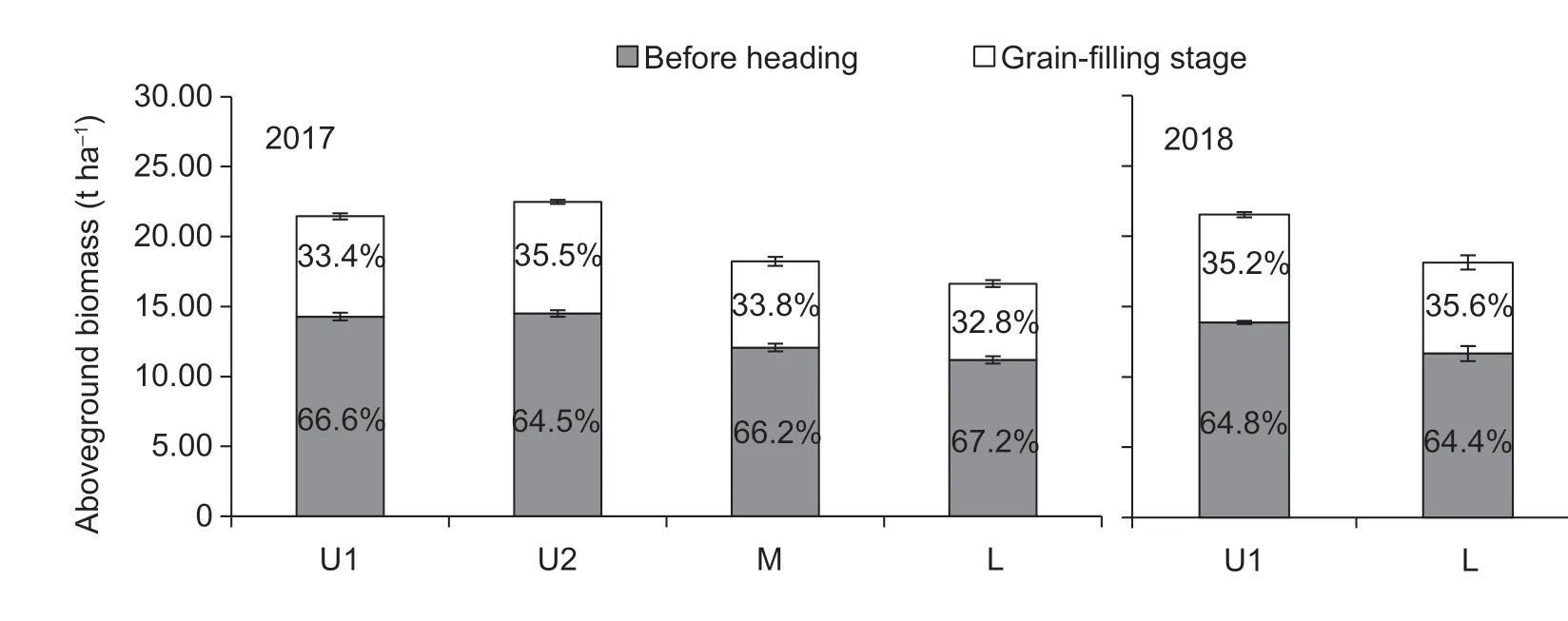
Fig.4 Geographic variation in the aboveground biomass of single-season high-yielding varieties in the upper reaches (U1 and U2) and middle–lower reaches (M and L) of the Yangtze River,China in 2017 and 2018. Bars mean SD (n=90,90,81,and 57 in U1,U2,M,and L in 2017; n=60 and 36 in U1 and L in 2018).

Table 5 Correlation analysis of yield and yield components and dry matter accumulation in different regions in 2017–2018
Further analysis the relationship between the dry matter accumulation and the yield components,we found that the dry matter accumulation at heading and maturity were both positively correlated with seed setting rate and 1 000-grain weight in the upper reaches of the Yangtze River,while the biomass accumulation at maturity was significantly negative correlated with grains per panicle. In the middle–lower reaches of the Yangtze River,the dry matter accumulated before heading was significantly correlated with seeding setting rate,and both the dry matter accumulated during grain-filling and the biomass at maturity were significantly correlated with grains per panicle (Table 7).
3.2.Growth comparison of the same cultivar planted in different regions
In 2017 and 2018,rice cultivar Tianyouhuazhan was planted in both the upper (U1) and the middle–lower reaches (L) of Yangtze River regions. There were significant geographic differences in yield and yield components,growth period,accumulated temperature,and solar radiation (Table 8),and the geographic difference of this cultivar was the same as what we had got by comparing a large number of local varieties (Table 5; Figs.3 and 5):compared with rice grown in the middle–lower reaches of Yangtze River (L),the rice grown in the upper reaches (U1) had more effective panicles,less grains per panicle,longer tillering period,and greater aboveground dry matter accumulation both before and after heading.
Further analyses showed there was a significant and positive correlation between panicle number per unit area and the duration and accumulated temperature during the tillering period (r=0.982*,r=0.993**,respectively); while the number of grains per panicle was significantly positively correlated with the accumulated solar radiation during the booting period (r=0.952*; Table 9).
4.Discussion
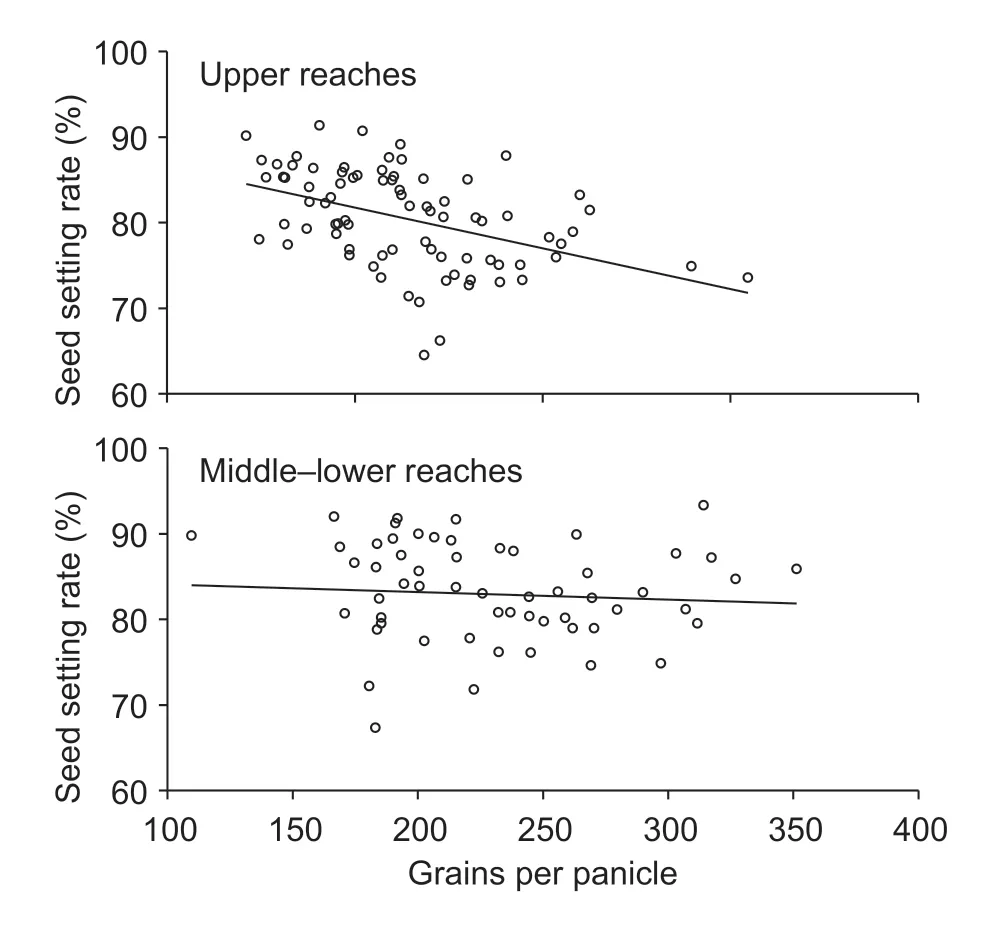
Fig.5 Relationships between grains per panicle and seed setting rate in the upper and middle–lower reaches of the Yangtze River.

Table 6 Correlation analysis of seed setting rate and yield components in different regions in 2017 and 2018

Table 7 Correlation analysis of dry matter accumulation and yield components in different regions in 2017–2018
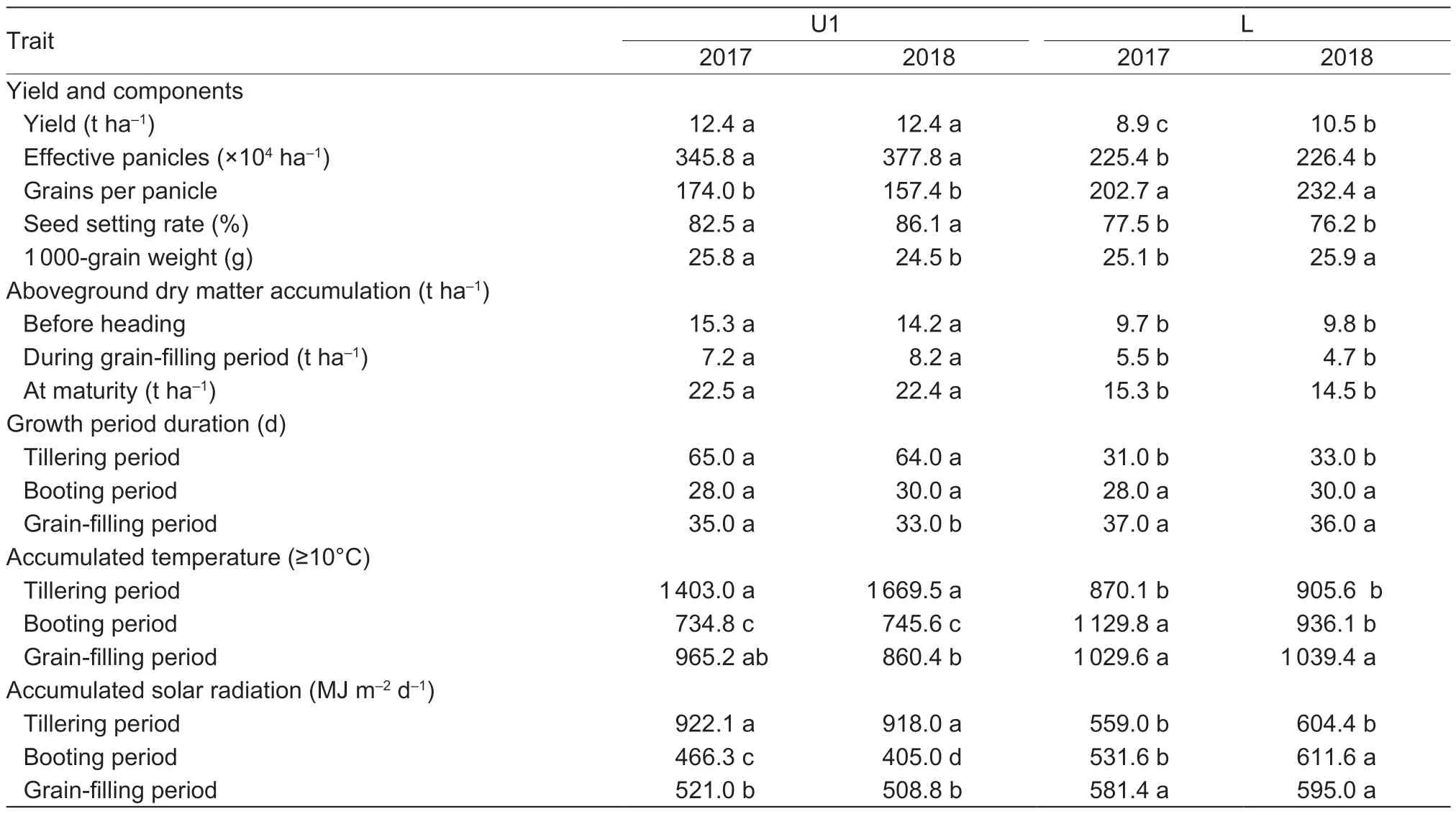
Table 8 Yield,biomass,growth period and accumulated temperature,solar radiation of the same variety Tianyouhuazhan planted in the upper (U1) and in the middle–lower (L) reaches of Yangtze River
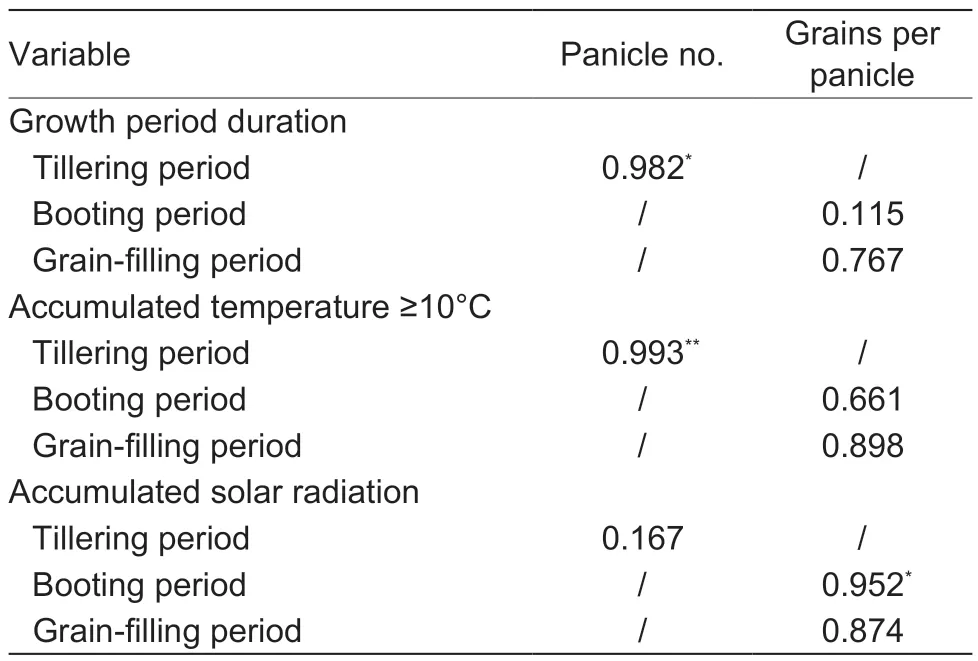
Table 9 Correlation analysis of the panicle number,grains per panicle and growth traits in different growth stages of rice variety Tianyouhuazhan
There are many studies on yield formation and biomass production in term of high-yielding production,however,those studies usually focused on one location,and the results from different experiments are often inconsistent or even contrasting. In this study,using the main local highyielding hybrid cultivars as materials,we compared yield components and biomass production in the upper,middle and lower reaches of the Yangtze River. We found that the grain yield in the middle–lower reaches of the Yangtze River was significantly correlated with grains number per panicle; while in the upper reaches of the Yangtze River,yield was significantly correlated with seed setting rate.Another obvious regional difference was that the effective panicle numbers increased dramatically while grains per panicle decreased obviously in the upper reaches compared with the middle–lower reaches of Yangtze River. When rice variety Tianyouhuazhan was planted in both in the upper and the middle–lower reaches of Yangtze River,60.2% more effective panicles while 23.8% less grains per panicle was observed in the upper reaches (U1) compared with in the middle–lower reaches (L). Our results are consistent with the findings of Yanget al.(2004),who compared the yield components of seven of the same rice cultivars that were planted in the upper reaches (Binzhou,Yunnan Province)and lower reaches (Hangzhou,Zhejiang Province),and found that the number of panicles per unit area in the upper reaches was 24–40% higher than that in the lower reaches,which contributed 70% of the yield increase.
This inconsistency in panicle traits could be due to differences in growth periods. We found that the average tillering duration in the upper reaches was 65.2 d,while it was only 38.2 d in the middle–lower reaches of the Yangtze River. The correlation analysis showed that panicle number per unit area was significantly and positively correlated with the length of the tillering period. Generally,delays in the sowing date shorten the vegetative growth period. The grain yield and panicle number per unit area decreased significantly when the rice seeding date was postponed from March 21 to April 10,and the number of primary tillers emerging rate from the 7th and 8th leaves of the hybrid cultivar Fyou 498 decreased by 40 and 97%,respectively(Zhonget al.2016).
Because the temperature and sunshine conditions in the upper reaches of the Yangtze River obviously diminished after August (Fig.1),in high-yielding rice production,rice should be harvested at the latest in early September;therefore,rice should be booting at the end of June and is usually sown before April 10. The total rice growing period in the upper reaches of the Yangtze River is approximately 150 d,which includes approximately 90 d for vegetative growth and approximately 60 d for reproductive growth.The longer the vegetative growth period,the greater the aboveground biomass before booting and the number of tillers that can grow into panicles. Therefore,compared with the middle–lower reaches of the Yangtze River,this region is advantageous in terms of the large number of effective panicles. Our research found a certain number of effective panicles was the prerequisite for high-yielding rice production in this region,among all the cultivars with an yield of more than 11 t ha–1in both 2017 and 2018,90.5% of them had an effective panicle number of 250–340 m–2,while only 2.4 and 7.1% of them had an effective panicle number lower than 250 or higher than 340 m–2,which means too few or too many effective panicles both have adverse effects,and there is an optimal range of effective panicles for highyielding rice production in the upper reaches of the Yangtze River. On the basis of an analysis of the yield components of 436 mediumindicahybrids grown in Sichuan Province in the upper reaches from 1986 to 2015,Liuet al.(2018)found that the spikelets per panicle increased from 130–140 to 170–180 and that the 1 000-grain weight increased from 27–28 g to 29–30 g,while the effective panicle number showed a decreasing trend,decreasing from 280–300 to 220–230 panicles m–2; moreover,no significant increase in rice grain yield had been observed in Sichuan since 1998.We believe that it is the blind pursuit of large panicles and the abandonment of the advantage of effective panicle number that has hindered the rice yield increase in this region.Comparing the yield traits of U1 and U2 in our experiment the yield traits in 2011–2015 reported by Liuet al.(2018),we detected a 34.9% increase in effective panicles and a 34.2% increase in grain yield in our experiment,while no significant difference was observed in grains per panicle,grain weight or seed setting rate. Therefore,instead of using large panicle size as the only characteristic of its high-yielding varieties,high-yielding rice production in the upper reaches of the Yangtze River should take advantage of the long vegetative growth period,select cultivars with medium panicle size,and adopt good crop managements during vegetative growth period to ensure a certain number of effective panicles (250–340 panicles m–2); fertilizer deep application,dry and wet alternate irrigation and those measures which can improve seedling quality are all effective measures to increase rice yield in the upper reaches of the Yangtze River.
Unlike the upper reaches of the Yangtze River,good light and temperature conditions can postpone the harvest time of rice in the middle–lower reaches of Yangtze River to mid-September to October. The varieties of hybrid rice in those areas are richer than those in the upper reaches,includingindicaandjaponicahybrid varieties. Therefore,the difference in the growth period between varieties in the middle–lower reaches is larger than that in the upper reaches of the Yangtze River. In the middle–lower reaches of the Yangtze River,the average vegetative growth period of single-season rice was approximately 64 d; excluding the seedling and returning green stages after transplantation,it was only 30 d for tillering. Not all tillers can bear panicles.It is generally believed that only tillers with more than three leaves at the initial booting stage are productive tillers(Menget al.2010). Leaf growth is climate related,and it usually takes approximately 5 d to grow a leaf in the vegetative growth period (Yin and Kropff 1996; Fenget al.2009). Therefore,productive tillers must be generated 15 d before initial booting; that is,the effective tillering time in the middle–lower reaches of the Yangtze River is only approximately 15 d,far less than the value of 40–55 d in the upper reaches of the Yangtze River. The short effective tiller occurrence period determines that the effective tiller or panicle number in this region is smaller than those in the upper reaches of the Yangtze River. However,good light and temperature conditions during the reproductive and grain-filling periods in the middle–lower reaches of the Yangtze River benefit the formation of large panicles,and the high yield of rice in this region is dependent more on panicle size than on panicle number and on aboveground dry matter accumulation more during the grain-filling period than during the vegetative period. Previous research results also confirm this; for example,Huanget al.(2011) found super hybrid varieties had 9.62% more spikelets per panicle than did common hybrid variety.
In addition to weather conditions,the sowing date of rice is also restricted by the crop growth period in the rotation system. Although delays in sowing date may reduce rice yields (Xuet al.2013),some farmers are reluctant to sow early in the lower reaches of the Yangtze River,even if time is permitting.This phenomenon is mainly due to the consideration of pest control; compared with rice sown in mid-late May,rice directly seeded in early June can avoid pests migrating from wheat harvested in mid-May in this region; and necessitates one fewer pesticide spray. The delayed trend of transplanting single-season rice was also confirmed by Zhaoet al.(2016),who examined the shift in the timing of rice transplanting during the period from 1991–2012. Under the condition that the vegetative growth period cannot be prolonged,planting varieties with large panicles,adopt good water and fertilizer managements during the reproductive growth period is a feasible way to achieve high yields in the middle and lower reaches of the Yangtze River; adoptable measures include base fertilizer deep application,proper application of panicle fertilizer,dry and wet alternate irrigation during the grain-filling period,etc.
5.Conclusion
Climatic factors vary substantially over southern China,the long tillering duration and high accumulated temperature during tillering period in the upper reaches of the Yangtze River are beneficial to tillering and increase of effective panicles,while the good light and temperature conditions during the reproductive growth period in the middle–lower reaches of the Yangtze River are conducive to the formation of large panicles. The grain yield in the upper reaches of the Yangtze River was positively correlated with the seed setting rate and the dry matter accumulation before heading,high-yielding rice production in this region should choose cultivars with moderate grains per panicle,and adopt good fertilizer and water managements during vegetative growth period to ensure a certain number of effective panicles(250–340 m–2). The grain yield in the middle–lower reaches of the Yangtze River was positively correlated with grains per panicle and dry matter accumulation during grain-filling period,thus high-yielding rice production in this region should choose cultivars with large panicles,strengthen the fertilizer management in reproductive growth period to benefit large panicle formation and increase dry matter accumulation during grain-filling period.
Acknowledgements
This research was supported by grants from the National Key Research and Development Program of China (2016 YFD0300108),the National Natural Science Foundation of China (31671630) and the earmarked fund for China Agriculture Research System (CARS-01-04A).
Appendixassociated with this paper can be available on http://www.ChinaAgriSci.com/V2/En/appendix.htm
杂志排行
Journal of Integrative Agriculture的其它文章
- Yield gap and resource utilization efficiency of three major food crops in the world -A review
- Reducing maize yield gap by matching plant density and solar radiation
- Cultivar selection can increase yield potential and resource use efficiency of spring maize to adapt to climate change in Northeast China
- Effects of different agricultural treatments on narrowing winter wheat yield gap and nitrogen use efficiency in China
- Determination of soybean yield gap and potential production in Iran using modeling approach and GIS
- Developing a process-based and remote sensing driven crop yield model for maize (PRYM–Maize) and its validation over the Northeast China Plain
